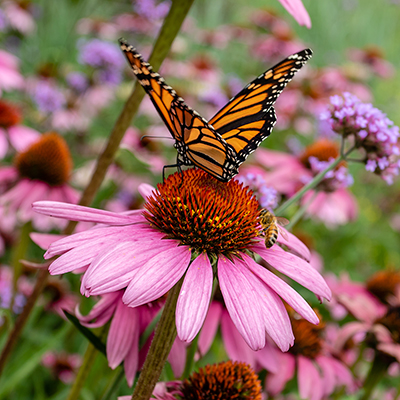Grow a Pollinator Garden with Seeds

Last updated May 6, 2025
Pollinating insects like bees and butterflies bring life to your garden in many ways. They support the ecology by helping plants reproduce and, in turn, feed on the flower nectar they need to survive. And when the pollinators show up in your garden, they bring the show, moving about from bloom to bloom.
Pollinators include butterflies and bees, as well as moths, beetles, flies and hummingbirds. Planning your garden with pollinators in mind is easy to accomplish, especially when you start with seeds that you start indoors or direct sow into the garden.
Table of Contents
Pollinator Favorites
How to Plant a Pollinator Garden
How to Care for a Pollinator Garden
A Pollinator-Friendly Yard
Pollinator Favorites

There are many attractive flowering annuals and perennials to grow from seed in your landscape. You can start seeds indoors before the season, or sow directly in the garden soil. If you’re a small space gardener, keep in mind that many of these plants thrive in containers.
When planning your pollinator garden, choose flowers and herbs with yellow, red, orange or blue petals and a fresh, mild sweet scent. Pollinating insects love plants with flat flower heads or blooms that grow in clusters.
Grow these pollinator favorite flowers from seed:
- Agastache
- Calendula
- Cleome
- Coneflower
- Cosmos
- Echinacea (coneflower)
- Gaillardia (blanket flower)
- Marigold
- Nasturtium
- Nicotiana (flowering tobacco)
- Penstemon
- Rudbeckia (brown-eyed Susan)
- Salvia
- Sunflower
- Tithonia (Mexican Sunflower)
- Verbena
- Zinnia
Grow these pollinator favorite herbs from seed:
- Basil
- Borage
- Chives
- Cilantro
- Dill
- Mint
- Oregano
Tip: There are many popular herbs like lavender that attract pollinators, but they can be challenging to grow from seed. Lavender is best grown from propagated seedlings.
How to Plant a Pollinator Garden

You can get a jump on the spring season when you start seeds indoors in late winter. Get some seed starting trays and seed mix and plant up trays for your garden. Transplant the seedlings when the ground warms in spring and all danger of frost is passed. See the frost date calendar for the average last freeze date for your location.
You can also direct sow seeds, like marigolds and zinnias after the last frost in spring. Be sure to pick a full sun site, at least six to eight hours each day. You can plant flowers and herbs in a raised garden bed or containers. Choose good quality organic soil and amendments and keep the seeds watered while they germinate.
Steps to direct sow seeds in your garden:
- Select a full sun site and clear the soil of any weeds or debris.
- You can amend soil with compost or garden soil.
- Rule of thumb for sowing seeds is to cover with soil that's about three times the size of the seed. Very small seeds need to be lightly pressed into the soil and covered with a small amount of soil. Larger seeds can be pressed into the soil with your thumb. Check recommendations on soil packet for the type of seed you're planting.
- Gently water the newly planted seeds. You can even use a mister to protect very small seeds.
- Check newly planted seeds each day for the first 10 to 14 days and gently water as needed.
- When seeds show their second leaves, called "true leaves," they're on their way.
Tip: Some seeds may require thinning, which is culling out weaker seedlings that will take nutrients away from otherwise healthy plants. To thin seedlings, just pluck out extras and discard them in your compost pile.
How to Care for a Pollinator Garden

Once established, give seedlings a 2-inch layer of mulch to keep down weeds and hold in moisture. Mulch with wood chips, pine straw or other organic mulches.
Keep your pollinator garden watered well. In summer, flowers will need about an inch of water a week, either from rainfall or irrigation.
For planters, water with a garden hose with a watering wand attachment. You can also use a watering can. In larger gardens, use drip irrigation, soaker hoses or other timed irrigation systems.
Boost blooms in your pollinator garden by using an all-purpose organic fertilizer mixed at half-strength.
Many flowers, like zinnias, need to be cut, pinched or pruned during the growing season. This actually encourages more blooms. So go ahead and cut the flowers and herbs for bouquets, that’s what they’re meant for.
A Pollinator-Friendly Yard

Growing a pollinator garden from seed is just the beginning. Try these tips for creating a pollinator friendly yard:
- Reduce or eliminate pesticide use from your landscape. And if you live in close proximity to other gardeners who spray, you may want to talk with them and explain the benefits of promoting pollinator habitats.
- You may enjoy creating a pollinator habitat so much, you’ll reduce your lawn and increase the pollinator plants.
- Let your neighbors and visitors know that your landscape supports pollinators with a decorative sign that says “pollinator friendly.” If you have children at home, let your little artists create a sign that you can post by your garden entrance.
Making a pollinator haven in your yard is easy and inexpensive when you start with seeds. When you're ready to plant, use The Home Depot Mobile App to find all the supplies needed to start a pollinator garden and attract the insects that will keep it healthy this season.








































